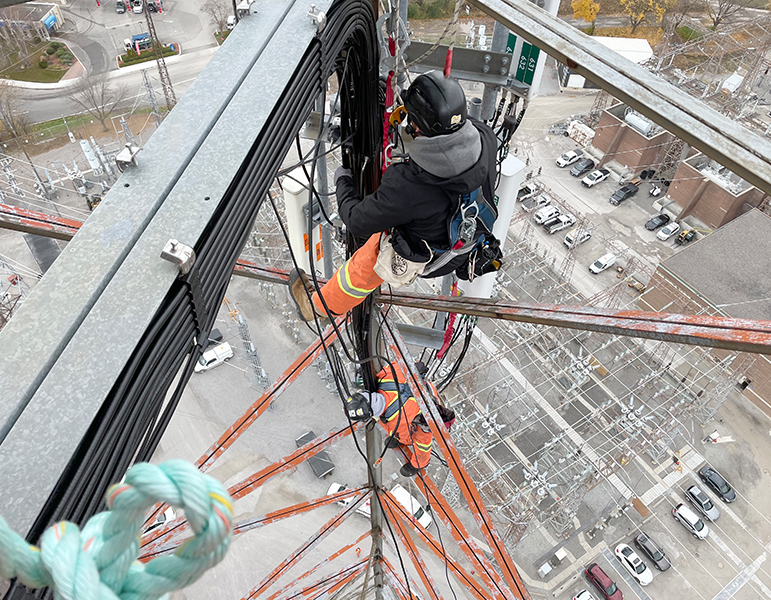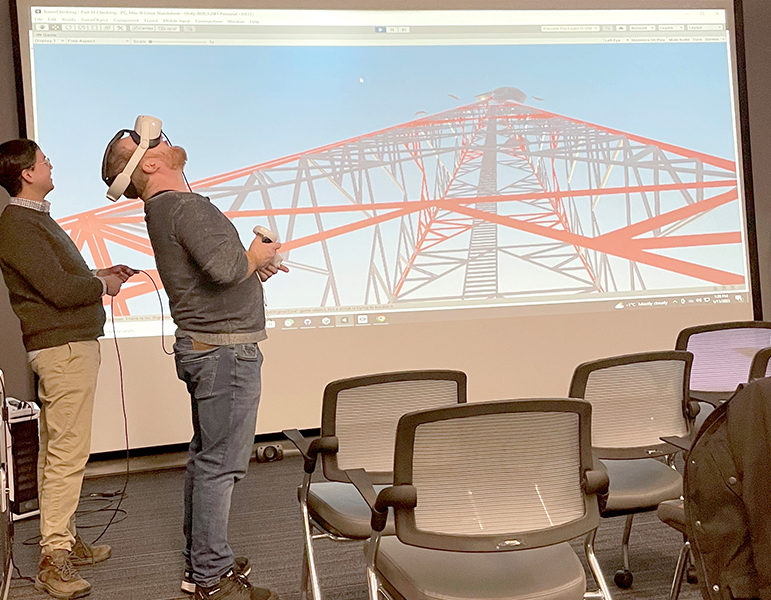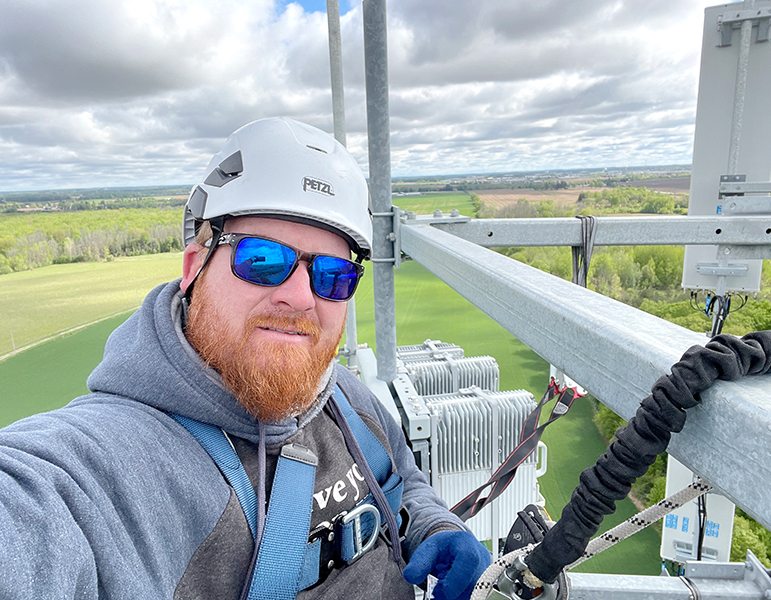Jason Wolf is passionate about his job.
The Palmerston resident works in the highly-specialized field of telecommunications, making sure towers are properly constructed and those working on the towers stay safe.
When he was “23 or 24,” Wolf got into the industry by chance.
“I really didn’t know where I wanted to go with what I was doing in my life. A friend of mine suggested that I try out the tower industry,” he said.
Wolf applied at a small company based out of Elmira, having never climbed a tower before in his life, and he heard the two magic words everyone wants to hear when applying for a job: you’re hired.
“They hired me on, gave me very little training, handed me a belt and expected me to go and work with three other gentlemen that I had never met before,” recalls Wolf. “They said, ‘You know, follow what these guys are doing and they’ll keep you safe.’ Luckily, I caught on quickly and was able to overcome my fear of heights, which is the biggest thing.”
From that company, he moved on to WesTower Communications – a bigger company with what Wolf describes as having some sort of actual training.
“I actually got some kind of formal training on working at heights, rescue training, RF (radio frequency) awareness,” he said.
Wolf worked in the field for 12 years before moving into a role as health and safety manager for the company.
“My job (as) health and safety manager was to take care of all the safety training and what not in Eastern Canada. So I flew around to their different offices – Newfoundland, Halifax, Montreal, Thunder Bay – stationed out of Elmira, and took care of their training,” he said.
None of which was regulated.
“And it’s still like that,” said Wolf.
Those working in the tower industry are not certified or “have a ticket” like other skilled tradespeople, such as electricians or plumbers – a sobering notion considering the aerial telecommunication industry is the second-most dangerous industry in North America (commercial diving is first).
“You hire somebody on brand new and you give them a harness. You have to give them working at heights and WHMIS (Workplace Hazardous Materials Information System) training. And that’s it,” he said. “It’s suggested that you give them rescue training, RF awareness, confined space, some kind of safety awareness training – that’s all suggested but not standardized.
“The training is missing.”
That is something Wolf and other industry leaders are hoping to change.

Those working in the tower industry are not certified or “have a ticket” like other skilled tradespeople, such as electricians or plumbers – a sobering notion considering the aerial telecommunication industry is the second-most dangerous industry in North America (commercial diving is first). (Photo courtesy of Jason Wolf)
Creating a training program
Wolf helped develop an organization known as the Structural Tower Antenna Council (STAC). The group helps ensure communications towers in Canada continue to be constructed and maintained with the highest regard to worker safety.
There are several committees in the STAC organization, one of which focuses on workplace development, whose goal is to have some sort of regulated training for those working in the industry.
That initial committee was made up of three individuals – Wolf, Erin Campbell and Jordan Camplin. Interestingly enough, all three are graduates of Norwell District Secondary School in Palmerston.
“It’s really cool,” said Wolf of the Norwell connection.
The committee worked on creating content that they believed should be a part of a regulated training course. During this time, Wolf went to work for another tower company.
“When I got hired on with Korol, (I learned) my boss (Zack Korol) was really passionate about having some kind of training too, but he wasn’t a part of STAC,” said Wolf.
Meanwhile, Korol and Rebecca Isowa, who is part of course development at Mohawk College, were working on finding funding and how a training course would fit into the college’s offerings.
“Neither side knew about each other,” said Wolf.
Once Wolf and Korol began working with each other, the two sides came together to work toward a common goal.
“That was a huge partnership,” said Wolf. “Because STAC had a lot of stuff already created, we were able to use some of that stuff to help build this program.”
Aerial Telecommunication Specialist Course
That program is the Aerial Telecommunication Specialist course, which will be offered at Mohawk beginning in the fall of 2023.
The course is not a degree or diploma, but a “micro credential,” says Wolf.
Training components of the course include:
– telecommunication fall protection;
– telecommunication rescue (high angle rescue training);
– radio frequency, fibre optic and electrical awareness; and
– introduction to telecommunication.
The course is a combination of in-person and online learning.
“They will have a head start on anybody that’s ever been in the trade,” said Wolf of those taking the course.

Jason Wolf tests the virtual reality tower climbing program that has been developed for the Aerial Telecommunication Specialist course being offered at Mohawk College. Wolf is one of the developers of the program, and will be teaching part of the course. (Photo courtesy of Jason Wolf)
Mohawk is also working on a virtual reality simulator that will allow students to virtually climb a tower.
In addition, the course will be available to companies for in-house training their employees and keep their training up to date.
“It’s not like this training, you take it once and you’re good for your life,” said Wolf. “Sure, going through Mohawk you’re gonna have your micro credential, you’re going to have that certification, but you’ve got to renew all of your training over the years… the renewals won’t be as in depth as what we’re doing at the school.”
One of the biggest challenges in developing the course was creating the content. Fortunately, Wolf and company had access to “The Guru” Mike Amyotte.
According to Wolf, Amyotte is the foremost expert when it comes to tower training in Canada. “He is essentially where I learned all this stuff from,” said Wolf.
After training countless individuals for the past two decades, Amyotte plans on retiring this year.
“All of his content, if he retires and doesn’t give it to anybody, it dies,” said Wolf. “He is the guru in Canada; he is the guy that a company hires and flies across Canada… the man is a very smart individual. I’ve taken his course probably four or five times.”
Amyotte was instrumental in helping the course developers create the content and ensuring that knowledge from “The Guru” lives on.
“It’s great that he was helping us out,” said Wolf.
The course has also received a helping hand from other industry partners. Some have provided in-kind donations – the VR project by Mohawk, for example – while others have donated equipment to be used in training.
“It’s been great,” he said. “The people we have approached with this, the support we’ve gotten, the donations… they’ve been awesome.”
Red Seal
Wolf’s goal is to see the tower trade become a Red Seal certified trade. This certification indicates that a tradesperson has demonstrated the knowledge required for the national standard in that trade.
“It needs to get recognized,” said Wolf. “Our cell phones aren’t going away anytime soon. If people didn’t have their cell phones, they’d be lost.”
A prime example was the Rogers outage last summer that caused a lot of panic and inconvenience across Canada.
With society relying on cell phones and telecommunications now more than ever, Wolf also wants to see more people get into the field.
“People just don’t really realize that the job exists,” he said. “Then you introduce them to it and they’re like, ‘Wow, this is a pretty interesting job.’”
Like many industries at the moment, the hiring pool for the tower industry is “very shallow” says Wolf.
“We could double the people in the industry right now and still be short,” he said. “The amount of work that’s out there, the amount of work that the carriers need done, we just don’t have the skilled people to go and do all of it.”




